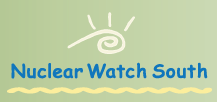
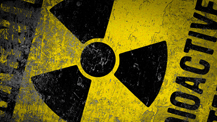
FUKUSHIMA NEWS
~ ~ ~ ~ ~ ~ ~
Help the
NO NUKES Y'ALL
campaign
y'all
Nuclear Watch South is a 501(c)(3) tax-deductible charitable organization.
{ thanks }
PayPal
It's your
safe and secure
way to donate on-line
 |
~ ~ ~ ~ ~ ~ ~
SAVANNAH RIVER PILGRIMAGE
COALITION OF SUPPORTING GROUPS
Blue Ridge Environmental Defense League
Center for a Sustainable Coast
Central Savannah River
Peace Alliance
Chattooga Conservancy
Clean Coast
Concerned Citizens
of Shell Bluff
Georgia Sierra Club
(Coastal and Savannah River Groups)
Georgia WAND
Hilton Head for Peace
Nuclear Watch South
Savannah Riverkeeper
South Carolina Sierra Club
Foothills Group of the
South Carolina Sierra Club
Southern Alliance for
Clean Energy

Educating and activating the grassroots to create a
nuclear-free future
~
PO Box 8574
Atlanta, GA 31106
404-378-4263
Cell 404-432-8727
info@nonukesyall.org
NO NUKES Y'ALL!
NUCLEAR WATCH SOUTH | SAVANNAH RIVER PILGRIMAGE
A SHORT REPORT FROM THE SAVANNAH RIVER PILGRIMAGE
A brief pause while we quarantine ...
EXPLORING THE LEGACY OF THE ATOMIC AGE ON THE SAVANNAH RIVER WATERSHED
SENECA, SC March 2020: This year marks 75 years of the Atomic Age and the Savannah River Pilgrimage 2020 will explore the South Carolina headwaters of the Savannah River in March to heighten awareness of the impacts of nuclear activities on the Savannah River watershed. SRP2020 is led by Bob Brooksher and River Dog with seasoned pilgrims Joanne Steele and her son Jesse Steele who paddled from the source to the sea in the Georgia watershed in 2015.
The pilgrims will be honored at a kick-off party on Sunday, March 1, 2020, from 1-5PM at the Sautee-Nacoochee Cultural Center in Sautee, Georgia.
A leadership summit will convene at Devils Fork Campground on Lake Jocassee to greet the pilgrims en route from Seneca River headwaters to the Oconee Nuclear Station over the weekend of March 5-7. The pilgrims expect to make landfall at Duke Power's three Oconee reactors on Monday, March 9.
Wednesday, March 11 marks nine years since the Fukushima radiological disaster began in Japan. The Savannah River Pilgrimage 2020 marks the occasion by teaming up with South Carolina Chapter of Sierra Club Foothills Group for a free screening of CONTAINMENT at Clemson University in the Osher Lifelong Learning Center at 6:30 PM.
New film documents
Source to Sea: Savannah River Pilgrimage
© 2018 ANDREW LINKER + DAVID GREEAR
VIEW ON YOUTUBE
Pilgrimage Honors the Savannah River
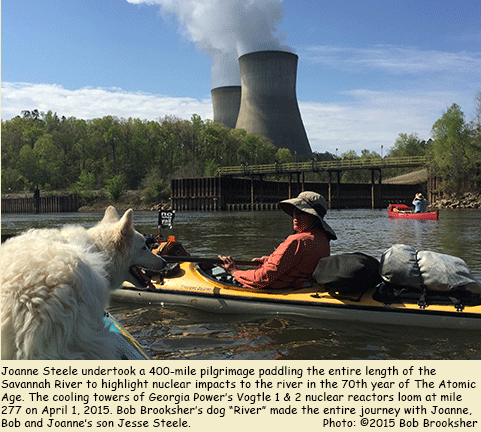
by Joanne Steele
It is not often that a vision comes to fruition with such grace and beauty as did our Source to Sea Savannah River Pilgrimage 2015. We traveled the length of this incredible river system in order to see it, assess its health, learn its history, meet its people, and attempt to raise greater awareness of threats it faces.
Water birds, otter, beaver, musk rats, deer, coyotes, bears, snakes, alligators, and feral hogs shared the river corridor. Wildlife tries to thrive in a threatened ecosystem everywhere. Even when the water looked and smelled awful we were surprised and given hope when we saw animal tracks. How much more life would thrive if this was not the 3rd most polluted river system in the U.S.?
We learned from activists, paddlers, fishermen, and community leaders along the way. Love for the river pervades top to bottom and transcends economic and political boundaries. We hope this love will lead to more unified action for river stewardship.
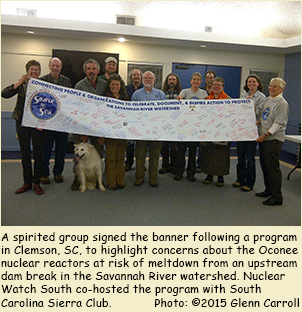 The Savannah River faces many threats. Potential nuclear disasters along the river exist in several locations. Probably the greatest and nearest threat is the Oconee Nuclear Plant downstream of the aging Lake Jocassee Dam. Dam failure would cause total meltdown of the three reactors.
The Savannah River faces many threats. Potential nuclear disasters along the river exist in several locations. Probably the greatest and nearest threat is the Oconee Nuclear Plant downstream of the aging Lake Jocassee Dam. Dam failure would cause total meltdown of the three reactors.
Down river industry threats include toxic releases, rising water temperatures, and siphoning off large quantities of water which concentrates the toxic releases. In addition, entire communities have been adversely affected. Shell Bluff is an isolated rural community south of Augusta where people had mainly subsisted on farming and fishing. Families had to change their way of life when The Southern Company constructed Plant Vogtle on the river there. River access was limited, land was taken, and there is still no safe evacuation route or response plan in the event of emergency at the power plant. Effingham County residents are fighting a similar threat from Kinder Morgan Company as it attempts to push a petroleum pipeline by declaring eminent domain on private property and on public lands.
Port Wentworh in Savannah is the 4th busiest in the U.S. The decision has been made to deepen the shipping channel by 6 additional feet to allow larger Chinese cargo ships often called “super tankers” to enter and exit the port. Proceeding with harbor deepening seems short sighted compared to the dangers. The Floridan Aquifer is a dome of freshwater extending from coastal South Carolina throughout Florida, and west through most of coastal Alabama. Millions of residents and businesses throughout the 100,000 square mile area rely on the aquifer for survival. Deepening the harbor could remove a layer of clay that seals the roof of the aquifer from salt water intrusion. Punching holes in the roof of the aquifer will pollute drinking water in the region.
It is incredibly expensive to fix and this outweighs any economic benefit from the larger container ships. Desalinization is expensive and dumps the excess heavy metals and salts out into the ocean upsetting the balance sustaining aquatic life. Citizens would bear the cost. The lower Savannah River struggles to supply itself with adequate oxygen. Unproven and expensive injection cones are proposed to put the river on life support due to harbor deepening. Goods the ships bring to the Georgia coast are important but most residents that we encountered feel that the port can continue to thrive at its current depth and a few larger ships is not worth the risk of an entire region losing naturally fresh ground water.
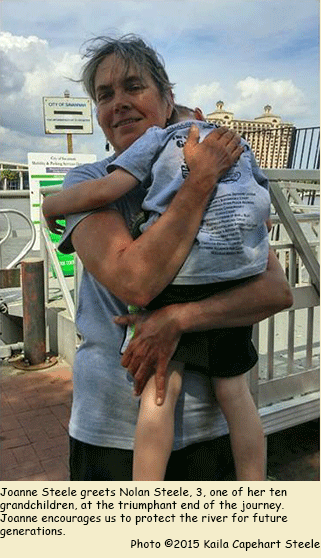 Seeing my grandchildren in Savannah brought it all home and galvanized my resolve. I feel the need to protect this beautiful river for future generations. We met so many people along the way who are fighting for this the river. This gave me hope.
Seeing my grandchildren in Savannah brought it all home and galvanized my resolve. I feel the need to protect this beautiful river for future generations. We met so many people along the way who are fighting for this the river. This gave me hope.
I invite you to join the growing movement to protect our rivers and to support clean, renewable energy. Water is the source of life that connects us all. The problems make me sad, yet I am happy to have learned more and grateful for the time I spent on the river. Andrew, David, Bob, and Jesse did an amazing job documenting the trip. My thanks to them and so many others. I can’t wait to see the documentary film!
This article first appeared in The White County News on April 23, 2015.
WTOC | SAVANNAH RIVER PILGRIMAGE 2015
Trio of kayakers travel length of Savannah River
SAVANNAH 4/10/15: The pilgrims received considerable press notice throughout the 400-mile journey including this nice promo and spot on Savannah's WTOC-TV MID-MORNING LIVE.
©2015 WTOC-TV: Savannah, Beaufort, SC, News, Weather
WTOC-TV: Savannah, Beaufort, SC, News, Weather
Citizen Groups Rally Around Pilgrimage
by Glenn Carroll
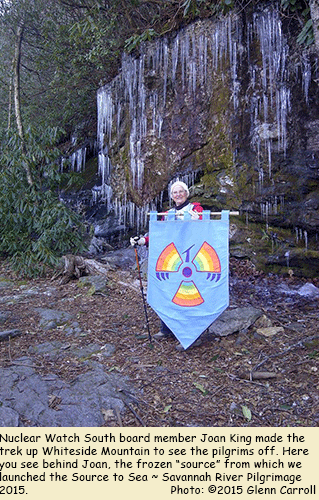 Environmental and peace organizations from "the source to the sea" along the Savannah River corridor rallied around the "Source to Sea ~ Savannah River Pilgrimage 2015."
Environmental and peace organizations from "the source to the sea" along the Savannah River corridor rallied around the "Source to Sea ~ Savannah River Pilgrimage 2015."
Joanne Steele first presented the project idea of a Savannah River pilgrimage to the December 2014 board meeting of Nuclear Watch South. Her vision was to acknowledge 2015 as the 70th anniversary of the Nuclear Age in a way that was locally meaningful, as there are five reactors, a major nuclear weapons manufacturing complex and a radioactive waste dump within the Savannah River watershed. Also, it is her family tradition to make a significant trip when turning 60, and, since her 60th birthday was March 1, this was the right moment.
Joanne started meeting with her long-time friend, environmental colleague and professional kayaker Bob Brooksher who also wanted to navigate the Savannah River from source to sea. Joanne's eldest son, Jesse Earl Steele, an experienced river guide, committed to make the five-week, 400-mile trip. Bob's dog River rounded out the core crew and they established a March-April timeframe for the trip to beat the bugs. The scramble was ON to let folks know about the project!
Georgia Sierra Club provided a conference call line and weekly calls were set up to organize events along the pilgrims' trip.
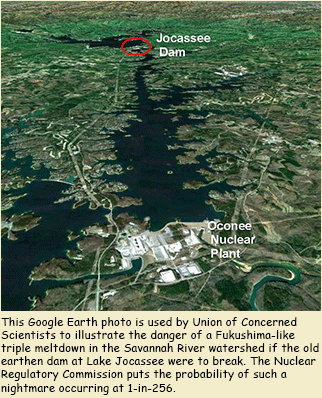 The pilgrims started from the source at the highest point of Whiteside Mountain, NC, on March 8. The first event, the commemoration of the 4th anniversary of Fukushima on March 11, was only three days into the pilgrims' journey, and the river pilgrims were, in fact, still on foot, following the mountain stream that becomes the Chattooga River (one of three rivers forming the Savannah River).
The pilgrims started from the source at the highest point of Whiteside Mountain, NC, on March 8. The first event, the commemoration of the 4th anniversary of Fukushima on March 11, was only three days into the pilgrims' journey, and the river pilgrims were, in fact, still on foot, following the mountain stream that becomes the Chattooga River (one of three rivers forming the Savannah River).
Buzz Williams and Chattooga Conservancy, Foothills Group of the South Carolina Sierra Club and Southern Alliance for Clean Energy teamed up with Nuclear Watch South to bring Mary Olson from Nuclear Information Resource Service to Clemson, SC, for a program highlighting the dangers of Duke Power's Oconee reactors. The three reactors are at risk from an upstream earthen dam break which the U.S. Nuclear Regulatory Commission (NRC) says has a 1-in-256 probability of occurring. The NRC says further that the 14-foot wall of water from the dam break would overtake the 7-foot walls protecting safety equipment and result in meltdowns of all three reactors. The question on everyone's lips is, "What will it take to make Duke Power make the safety wall higher?!" Buzz Williams of Chattooga Conservancy shared chilling tales of local NRC complacency.
Following the Fukushima day program, the pilgrims paddled through two states and over several lakes which were created when the rivers were dammed to generate electricity. While they wended their way to the next big population center, Augusta and the March 28 anniversary of Three Mile Island meltdown, representatives of 15 groups held weekly phone conferences to line things up.
 Groups rallied around several projects in Augusta including outings on the Augusta Canal and Savannah River, a potluck party at the Savannah Rapids park pavilion by the Augusta Canal, a visit with Augusta Mayor Hardie Davis, and an early morning roadside clean-up.
Groups rallied around several projects in Augusta including outings on the Augusta Canal and Savannah River, a potluck party at the Savannah Rapids park pavilion by the Augusta Canal, a visit with Augusta Mayor Hardie Davis, and an early morning roadside clean-up.
Sam Booher and Savannah River Group of the Georgia Sierra Club oversaw loads of logistical set-up and Savannah Riverkeeper gave keen guidance to support the pilgrims on the water. Rev. Charles Utley lined up Blue Ridge Environmental Defense League and Concerned Citizens of Shell Bluff to put on a big fish fry at the Pavilion Party and Bernice Johnson-Howard of Georgia Women's Action for New Directions (WAND) helped arrange transport for local rural folks to attend. Central Savannah River Peace Alliance rounded out the strong coalition support in Augusta.
Meanwhile, the controversial Palmetto Pipeline to run along the Savannah River was announced, and water permit hearings about Vogtle 3 & 4 reactors were scheduled. The group's regular phone meetings became hot, timely organizing tools and the activist coalition we had hoped the pilgrimage would foster was already springing into action.
The next big stop for the pilgrims was a dinner reception with Georgia WAND in Shell Bluff, closest neighbors to Georgia Power's Vogtle reactor complex and directly across the river from Savannah River Site nuclear weapons complex. The riverside community was eager for reports on the pilgrims' sense of the river's health. The visit to Shell Bluff coincided with a national waterkeeper alliance conference at the local campground at which the pilgrims were given overnight hospitality and celebrity treatment.
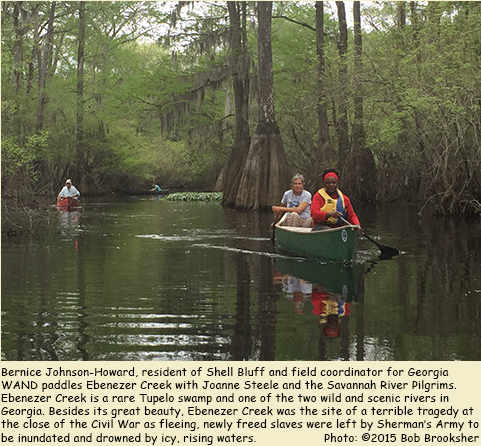
As the pilgrims headed South and downstream of Augusta, the character of the river changed considerably from the impacts of population, pollution and industry. And the pilgrims also passed into the capable, organizing hands of Sierra Club's Karen Grainey and Environmentalist-at-Large Claudia Collier and the hospitality of Coastal Group of the Georgia Sierra Club, Center for a Sustainable Coast, Clean Coast and Hilton Head for Peace. Claudia and Tommy Deadwyler helped line up events in Springfield, Georgia and an outing on Ebenezer Creek, one of Georgia's two wild and scenic riviers and the site of tragic drowning deaths of 600 just-freed slaves following Sherman's "March to the Sea" at the close of the Civil War.
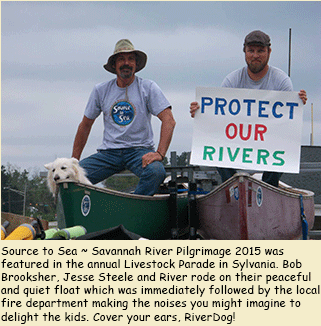 The pilgrims stopped in Screven County for the annual Livestock Festival and participated in the parade and festival parties.
The pilgrims stopped in Screven County for the annual Livestock Festival and participated in the parade and festival parties.
Then it was Savannah and Tybee Island HO!
Upon arriving in Savannah, the pilgrims delivered the letter from the mayor of Augusta to Savannah Mayor Edna Branch Jackson and then raced to the local TV station for a spot on Mid-Morning Live. Then everyone hooked up with Emory students who were in town for a clean-up with Clean Coast and several students spontaneously decided to join the outing to the Tybee Island lighthouse and the grand finale to a glorious project!
It was inspiring to see Georgia and South Carolina citizens' groups come together on short notice to capably share opportunity and responsibility for our Savannah River, the third most polluted river in the U.S. We have built a strong new coalition with which to face the myriad existing and proposed threats to the Savannah River watershed and made many new friends with which to share its beauty.
"To the village square
we must carry the facts
of atomic energy.
From there must come America's voice."
ALBERT EINSTEIN
~~~~~~



